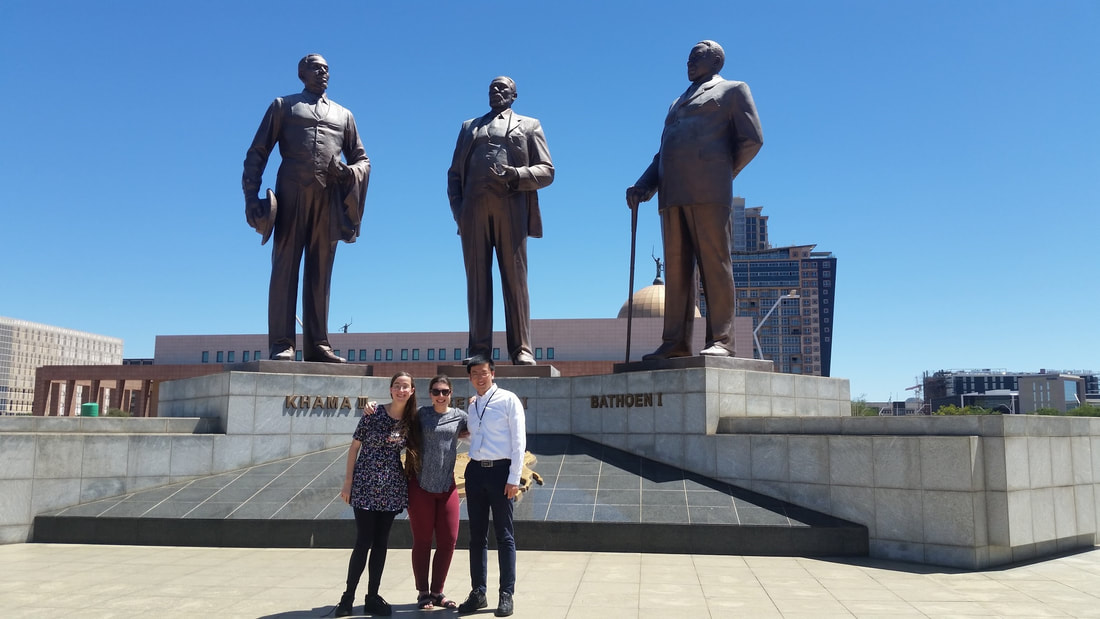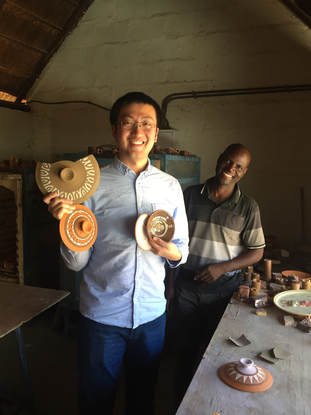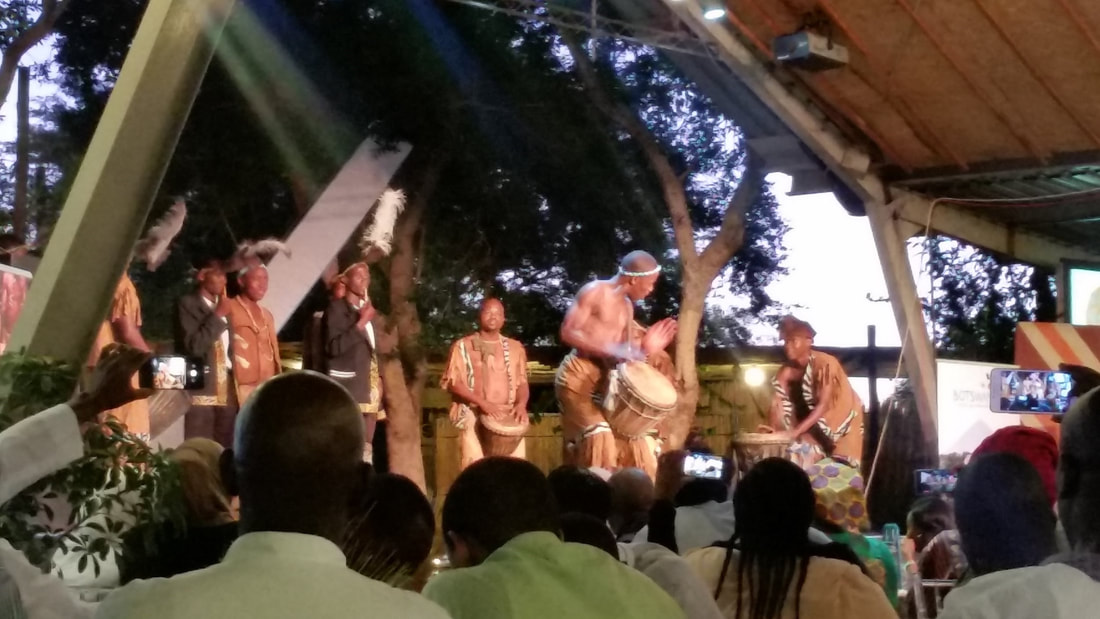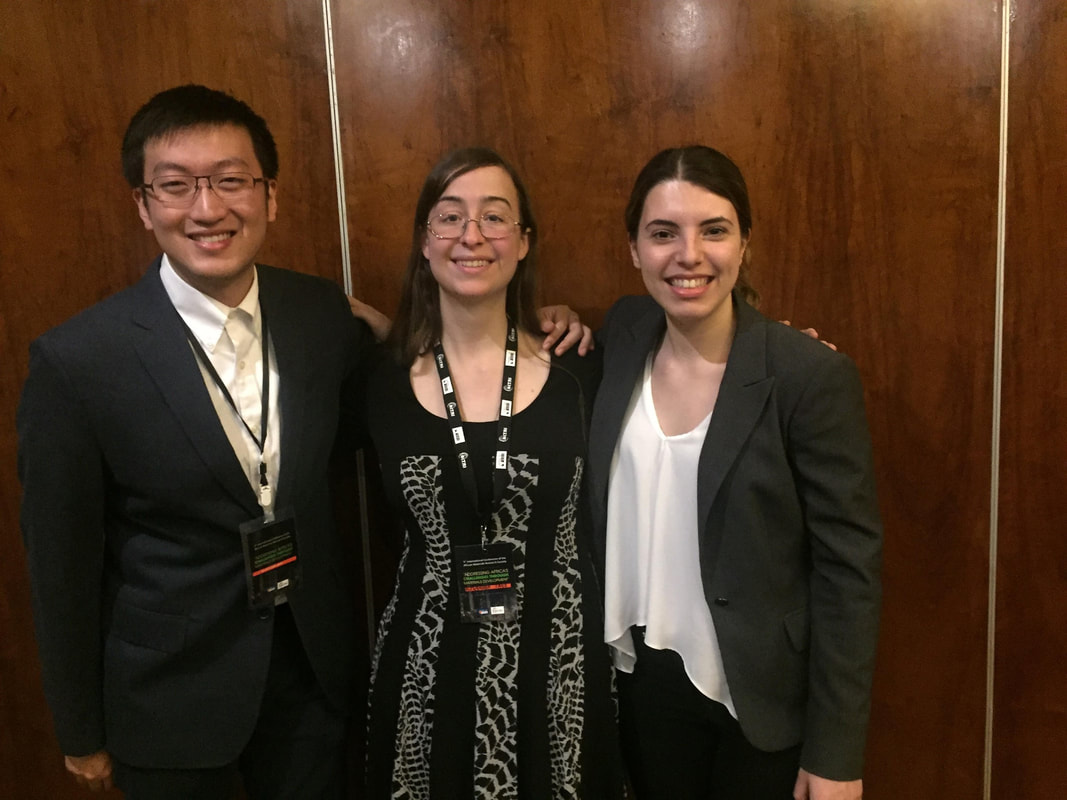SciBridge Participates in the 9th Annual African Materials Research Society (AMRS) Conference3/11/2018  SciBridge student members John Wang, Alex Hsain, and Alexandria Cruz traveled to Garborone, Botswana in mid-December to deliver a presentation on SciBridge at the 9th International Conference of the African Materials Research Society (AMRS). They also had an opportunity to present their own respective research projects in the Energy symposium and Nanotechnology symposium. SciBridge U.S. Coordinator Dr. Veronica Augustyn organized the AMRS Symposium on Materials Education, Networking, and Innovation Symposium, and SciBridge Africa Coordinator John Paul Eneku presented the efforts of the African network at the symposium. The conference was held from December 11-14, 2017, and included two days of pre-conference workshops, drawing over 400 participants from across the world. The aim of AMRS was to bring together an international scientific audience to build knowledge, foster relationships, and promote fields of research in materials science. The themes of AMRS 2017 reflected issues specifically relevant to Africa such as energy and water, but also held relevance to the global research community. We interviewed the U.S. SciBridge student volunteers after their trip to learn more about their experiences. How did AMRS aid in your professional, academic, or personal goals? Alex: Interacting with students from Africa and across the globe was an immensely humbling experience -- one which helped build my global perspective as a scientist. Through workshops, seminars, dinners, and festive outings, we grew and fortified our SciBridge network. In the education symposium, we embraced new languages and pedagogical methods, “ìyá ni wúrà” or “mother is gold” in Nigerian, was used as an example of relating human experience to materials science. In the Joint Undertaking for an African Materials Institute (JUAMI) session, students brought up the importance of contextualizing science to its unique environment when creating learning resources. Plenary speakers in the morning broadened our perspectives on energy research relating to solar, electrochemical energy storage, and nano systems. Panel discussions revealed the importance of Africa using its unique resources to build an economy of entirely its own. John: The AMRS trip was an intense and rewarding experience. In terms of professional goals, I had my first teaching experience during the pre-conference tutorial on scanning electron microscopy (SEM). What I learned from preparing lecture materials for Prof. Beth Dickey on SEM fundamentals and teaching my lecture on SEM simulations will be beneficial when I need to pass my knowledge to other people. The people I met in Africa are probably the most memorable part of the trip. Some of them may be important not only for my personal professional network but also for SciBridge. The oral presentation on my own research gave me more experience presenting research to different audiences and made more people aware of our work. The trip to Botswana initiated my familiarization with the country and the African continent. Experiences such tasting oxtail, witnessing sleeping lions, and conversing openly about the advancement of science has deepened my connection to Africa and SciBridge. Alexandria: I had a chance to explain my research to a scientific audience who did not specialize in magnetism and this helped me practice how to explain the impact of my research. It was amazing to meet people from all parts of Africa and listen to the challenges that they face. It is important to understand the particular problems the continent is facing and to see how people would like to approach the solution. It was surprising (also a bit unsurprising) to learn that different people have different way of solving problems and what works for one person may not work for another. Communication is vital for finding solutions and addressing the root important problems, not just tackling problems on the superficial level. Africa is unique in its people and its resources and can find novel ways to build its economy. What was your favorite speaker or workshop and why? Alex: My favorite part of the conference were the JUAMI student presentations. I loved learning about the other student projects that came out of JUAMI and seeing SciBridge in a larger context. There were many valuable lessons I learned there including the importance of self-sustainability of educational projects, as well as the importance of contextualizing science in different cultures. John: My favorite speaker was Prof. Paul Weiss (UCLA) for his engaging talks and his way of embedding jokes into the talks. My favorite workshop was the panel discussion in the Materials Education, Networking, and Innovation Symposium on how to make resilient networks. I liked it because it brought in brilliant people from vastly diverse backgrounds to address specific problems. A lot of good concerns were raised and the panelists gave inspirational insights. Audiences were closely engaged in the discussions and gave great remarks. Professor Osseo-Asare’s (Penn State/Univ. Of Ghana) remark on the need for African researchers to do research based on the needs of Africa instead of following what the U.S. is doing was eye-opening for me. Alexandria: My favorite part was the panel discussion in the Materials Education, Networking, and Innovation Symposium, because the audience was able to actively participate in the discussion. I asked about how to get African universities access to the equipment that they need for research and it spurred discussion about using older equipment and sending students to become trained on using and repairing equipment. One professor expressed interest in building cost effective versions of their equipment. Everybody brought up insightful points and it was encouraging to talk about ways to obtain equipment needed for publishable research from collaborations and donations to company sponsorships.  What did you think of Botswana? Where did you explore? Alex: Gaborone, Botswana is a beautiful up-and-coming city. Students from JUAMI joined together at a local Ethiopian restaurant where we shared a traditional communal dinner. Our SciBridge group also participated in a city tour where we went to see local landmarks such as the statue of the Three Chiefs, the art museum, Botswana University, and the city football stadium. One of my favorite nights was at Botswana Craft where all the conference participants assembled for a festive night of traditional Botswanan dancing, music, and cuisine. I interacted with students from Nigeria, bought memorable souvenirs for my mentors back at home, and danced with John Paul Eneku and John Wang on stage with the professional African dancers. John: Botswana is a promising developing country. In the north part of the country, there is a great tourist site, the Okawango Delta. The country also has great natural resources like diamonds, and exports high-quality beefs. The people I met are smart, open and diligent. I didn’t encounter any resistance when I talked to a pottery shop owner about the homogeneity of his furnace, sintering process of ceramics, color of different metal oxides in pottery dyes, applications of metal oxides in batteries, etc., and he taught me how to apply glaze to the surface of pottery by glassifying a layer of silicon oxide slurry. I was impressed by how well he embraced science. The experience was deepened for me further when I learned his daughter was working on a Ph.D. degree in microbiology in South Africa. Considering that the country’s future president shows a considerable amount of passion in supporting science, I personally think Botswana has a promising future because science and engineering will be critical to bring more value to their abundant natural resources. I hope they can find their own path in science and engineering and develop their own advantages in specific areas. In Botswana, I explored the capital city of Gaborone and a few villages around it. In the villages, people make crafts like pottery and table mat souvenirs, and sell the crafts to gift shops. Alexandria: Gaborone is a growing and an amazing city to visit. I really loved looking at the art in the city. In Botswana Craft, there were many beautiful weavings and wood carvings. One of my favorite art pieces were images of flowers and women that were created from butterflies’ wings. Other interesting pieces were the beaded statues and I was so excited to get a mini beaded elephant statue. I also recommend the art museums, because there are many amazing pieces that reflect the issues affecting people in the city. Did you make any side excursions in Africa or elsewhere?
Alex: We spent a couple of days after the conference in Madikwe game reserve in South Africa. That was an incredible opportunity to get close to some of the wild life including lions, rhinos, giraffes, elephants, and zebras. We spend two days tracking a pride of lions and learning their particular habits and getting to know their family. The beauty of Africa was readily apparent during the 5-o-clock in the morning game drives as the sun rose over the grasslands. John: I also did a day-trip to Madikwe game reserve in South Africa. It was great to see animals in a natural habitat. Alexandria: Our guide at Madikwe was amazing and she told us about the animals, how they track them, and the problems of poaching. The jeep had no doors or windows, so it was pretty scary when a lion passed by the side of the vehicle, but our tour guide was calm and told us to stay still. No need to tell me twice! Another time we saw two elephants giving handshake with their trunks. I got to learn a lot -- lions don’t attack anything that moves and roar when communicating; rhinos can be a bit shy; nobody messes with elephants. Well it sounds like you had a great time! What can we learn from AMRS to better build the SciBridge community? Alex: Learning from other students and faculty that had gone on and created successful U.S.-African collaborations put the role of SciBridge into perspective for me. I learned that SciBridge occupied a similar role to undergraduate research or REUs here in the United States. SciBridge gives undergraduate students a unique opportunity to get involved in research and start their own independent projects. However, through interacting with our African collaborators, we began to get a sense of the challenges encountered by students. The largest one was the time required out of class to participate. In the U.S. students receive either class credit or stipends to conduct undergraduate research. To combat this issue, we have begun to make efforts to integrate SciBridge seamlessly into classroom curricula. John Paul Eneku has made the SciBridge kits a part of the 3rd year independent research projects at the Dept. of Physics at Makerere University. On the U.S. side, we have made efforts to deepen the educational resources we provide by creating step-by-step lesson plans and tutorial videos. Additionally, we have started to create “modules” that build off of one another to extend students’ understanding of thermoelectrics. The perspectives we gained at African MRS were critical to our understanding the obstacles our partners face, and helped us to come up with ways to address them. John: For the SciBridge alumni, we can think about forming a network or advisory board to keep some SciBridge graduates connected. For African students, we need to initiate conversations with the African student body to see how we can set up a sustainable and professional communication program between U.S. and African students. Communication through Whatsapp can be difficult to maintain. Maybe we can organize online semi-live seminars to ask the students to present their research. By semi-live seminars, I mean the presenter will upload few screenshot of slides onto a communication platform and then upload audios to present the slides. In this way, the data needed to convey information will be minimized. For the NC State chapter, we are trying to make SciBridge a more involving activity. Alexandria: Collaborations need to keep on happening because no single person has all the skills needed to make kits. We need people reaching out to companies and labs for older research equipment for publishable results. We could also reach out to the JUAMI students for collaborations on future kits/infrastructure. Some of the JUAMI students have awesome kits and SciBridge could expand on them. We need to reach out to people in education, graphic design and video editing to improve the quality of the kits. We should also talk with African students to learn more about issues affecting Africa specifically to make kits more relevant to them. I would like to stay in contact with the people I met in the conference, because it would be amazing to have SciBridge allies all around the world to make the biggest impact possible. A big thank you to the granting agencies that allowed for our SciBridge members to experience African MRS: NC State East Africa Initiative (Alex Hsain, Veronica Augustyn, & John Paul Eneku), U.S. National Science Foundation (Veronica Augustyn, John Wang, & Alexandria Cruz - as part of JUAMI), and the Microscopy Society of America (John Wang). We look forward to making use of the lessons you brought back from the conference!
2 Comments
|
Archives
February 2023
|



 RSS Feed
RSS Feed
